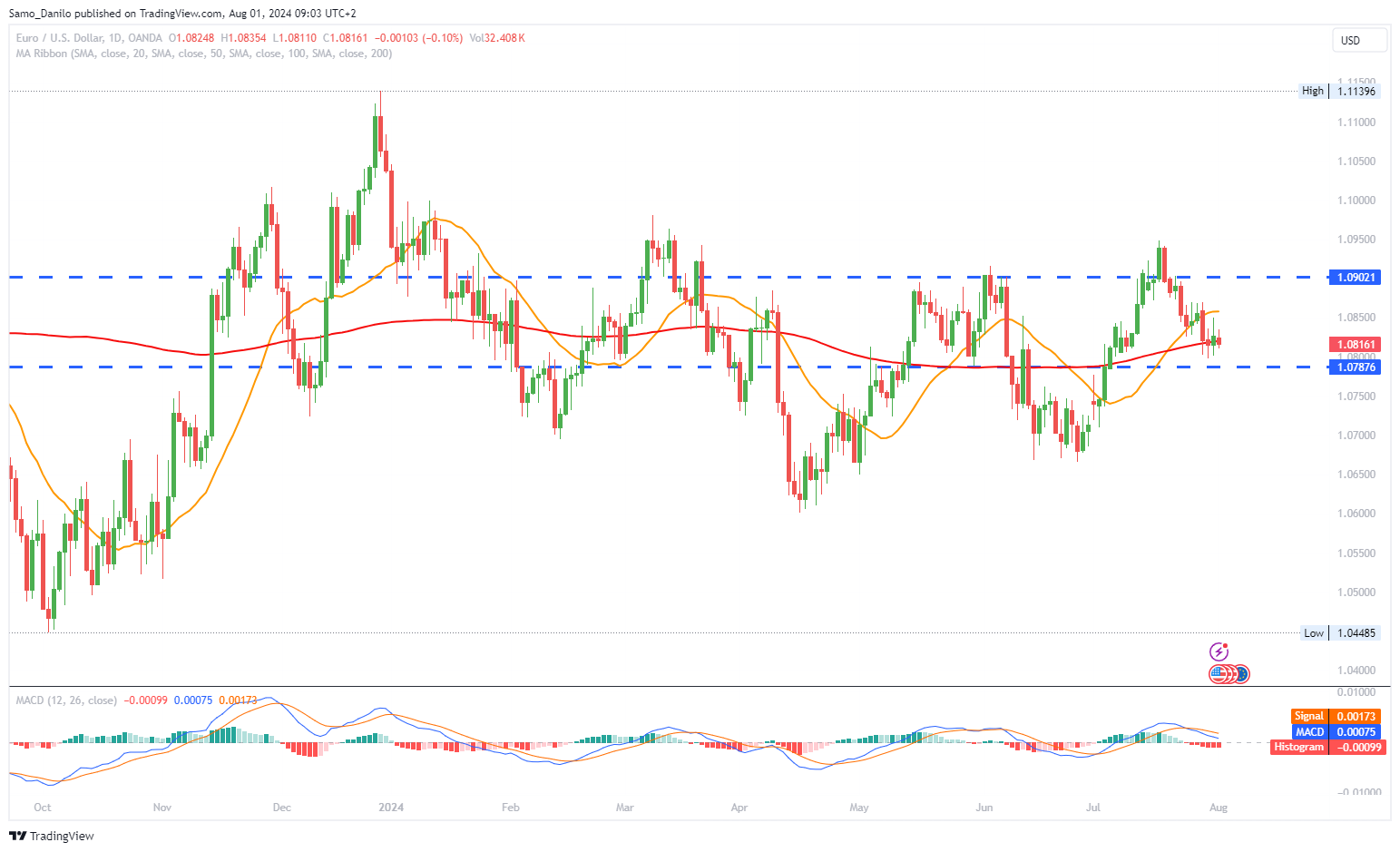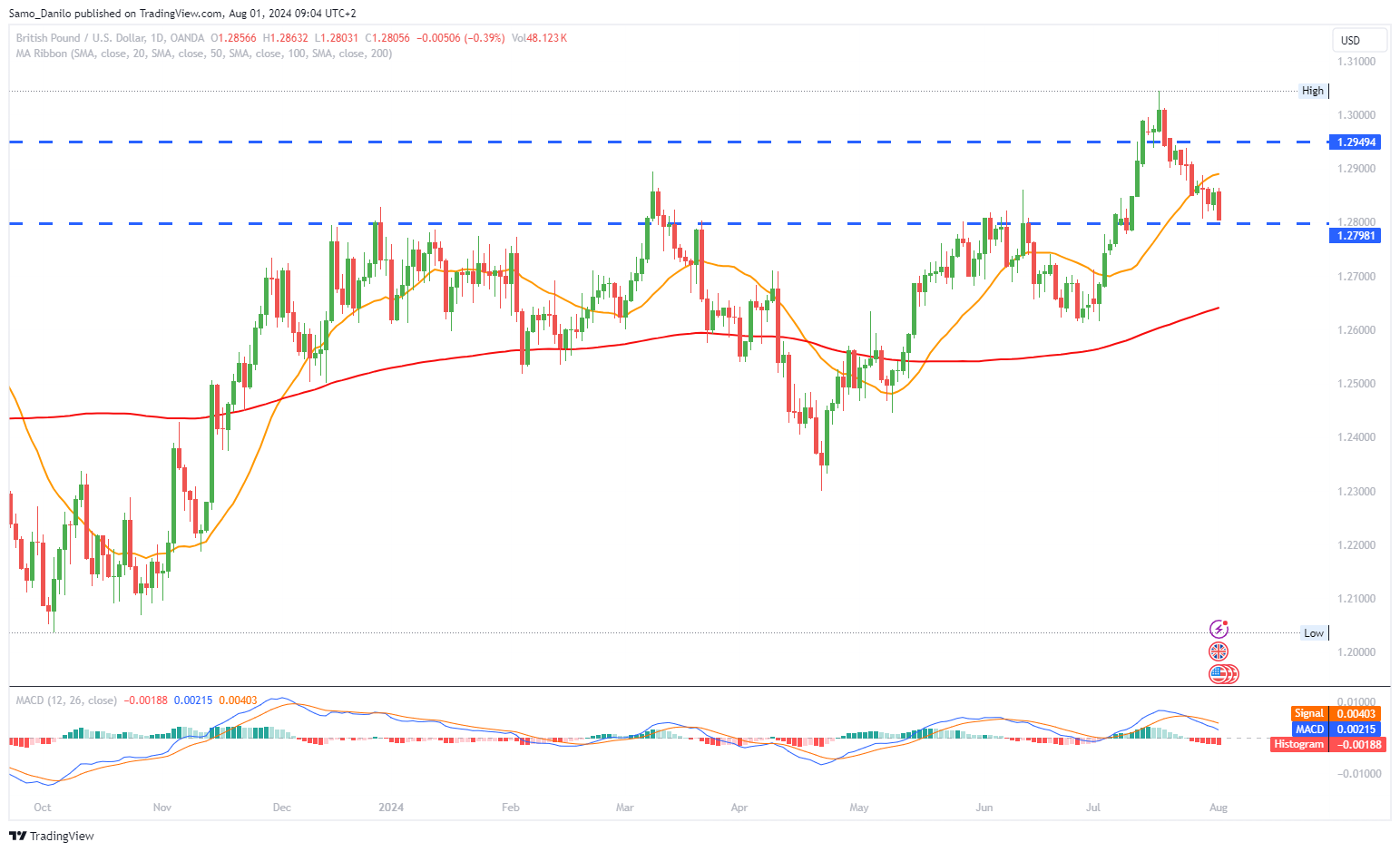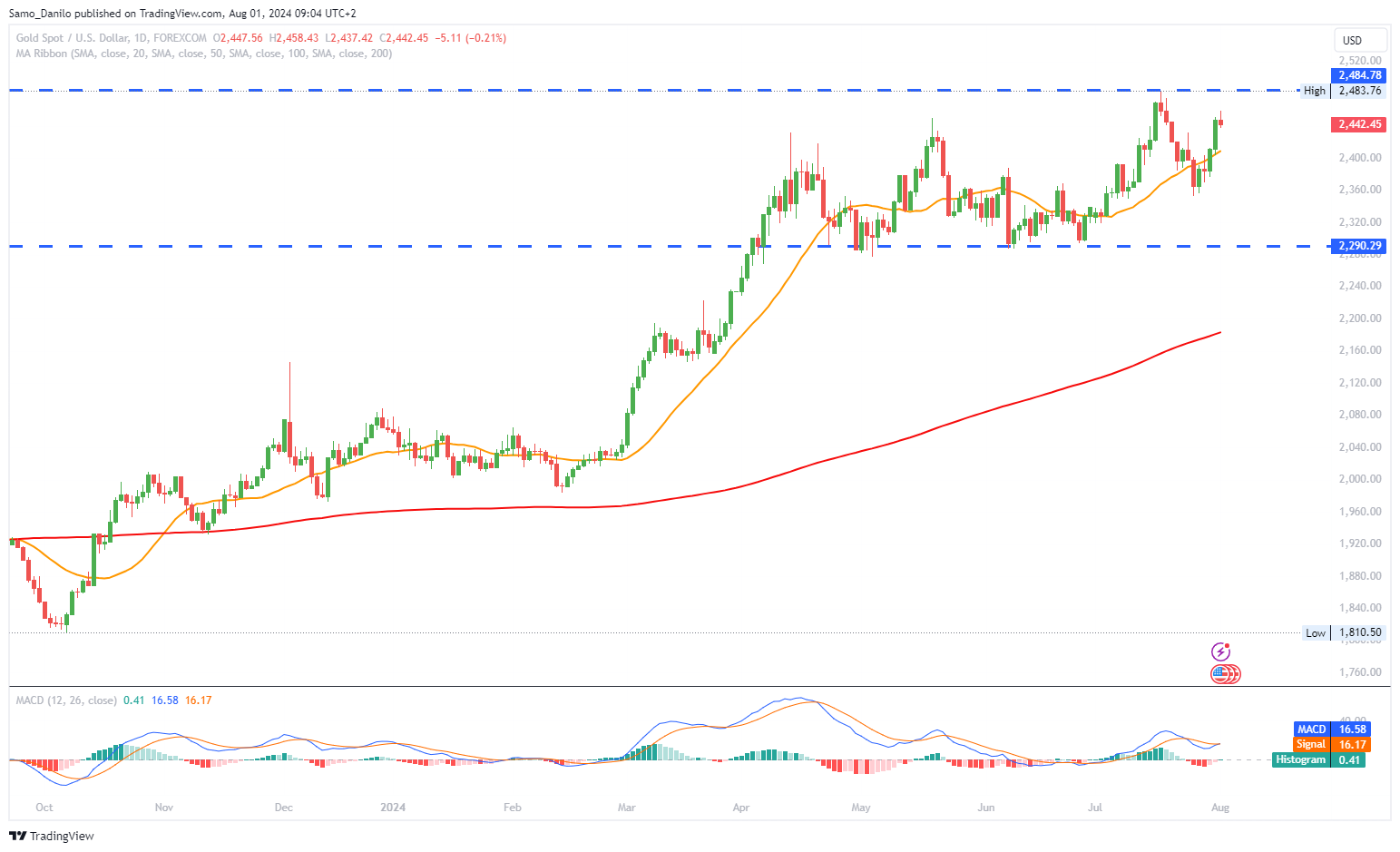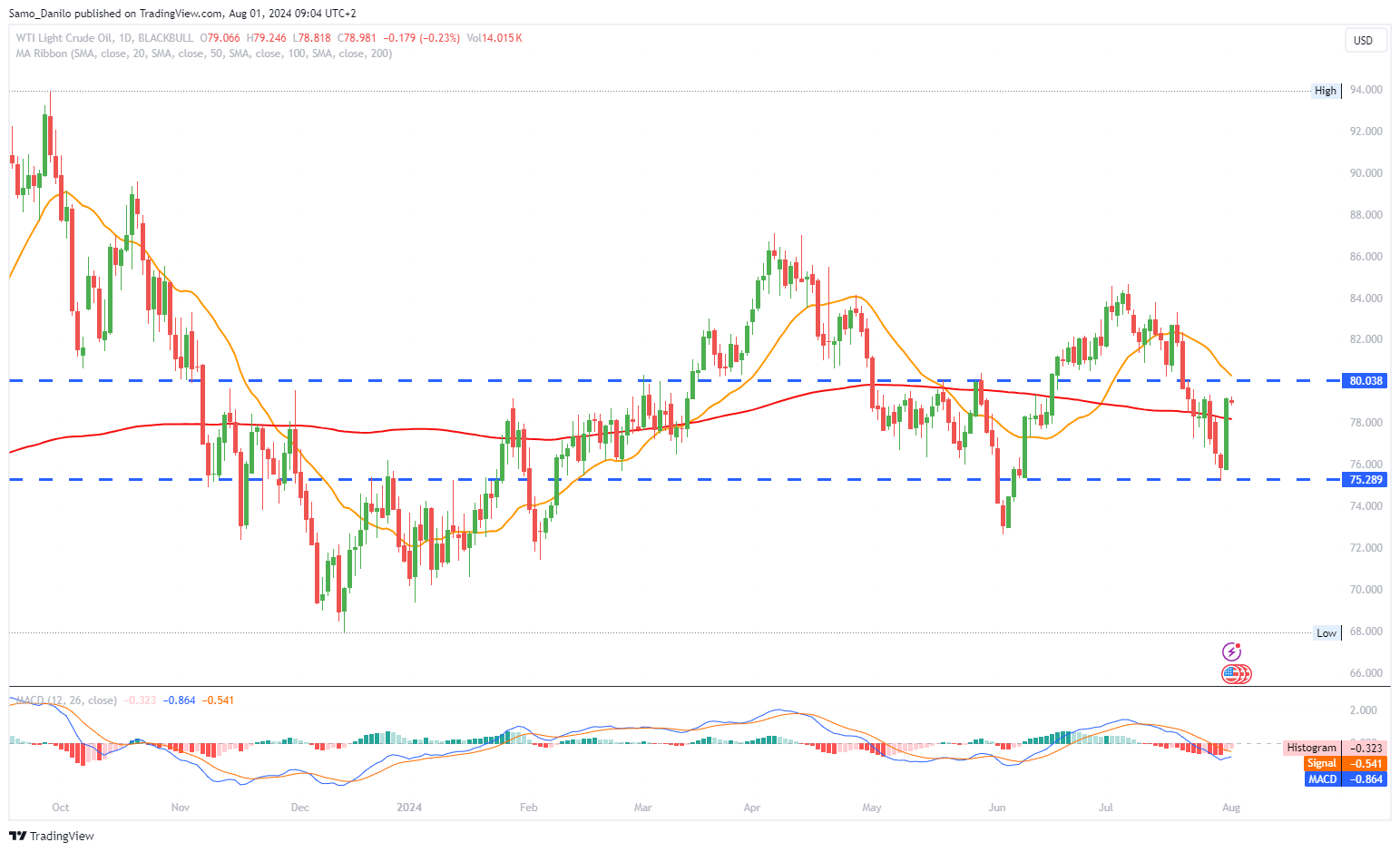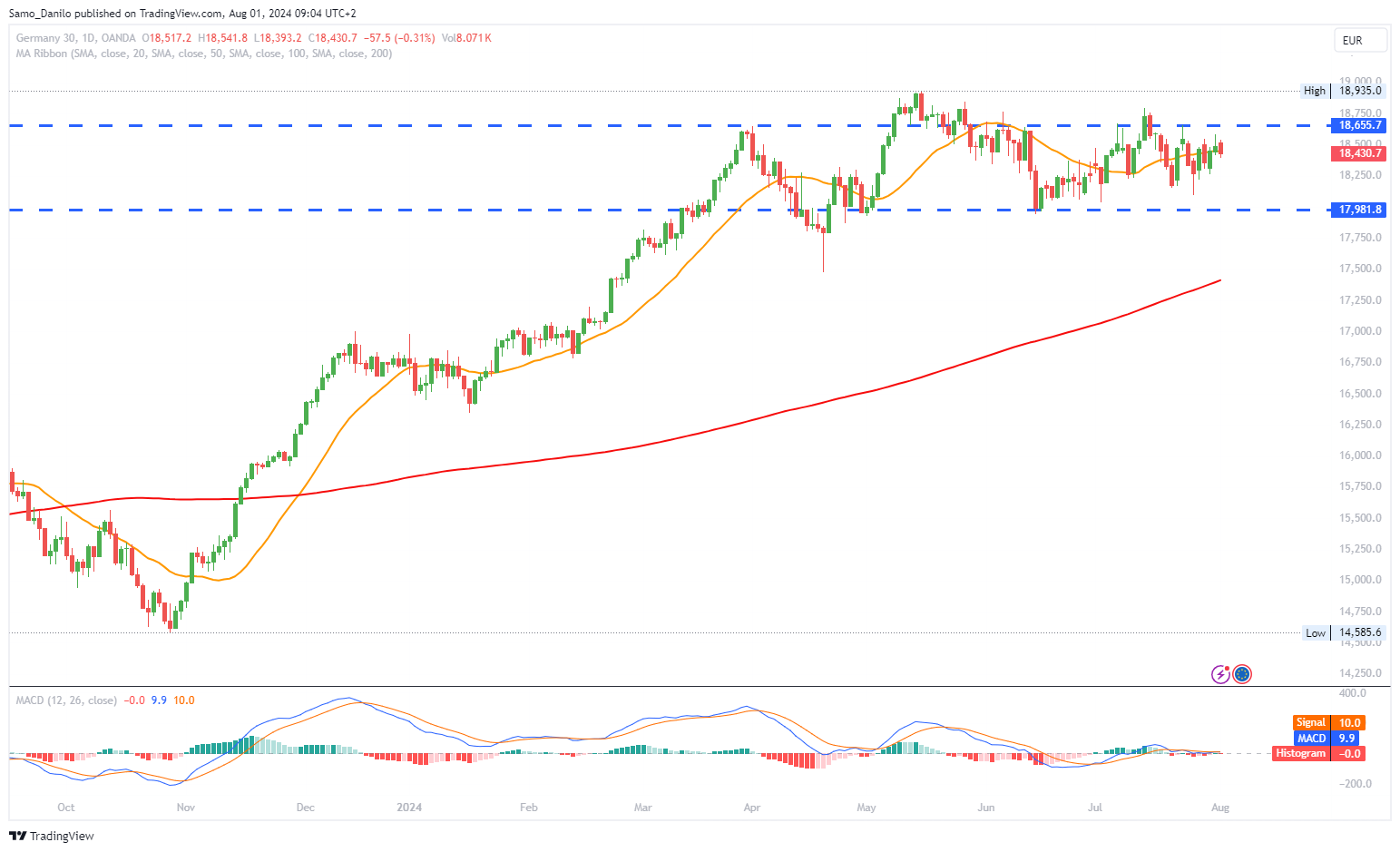EURUSD
- Recovery and Gains: EUR/USD recorded acceptable gains on Wednesday, reversing two daily declines amidst a weaker US Dollar (USD) following the FOMC gathering on Wednesday.
- Fed’s Interest Rate Decision: The offered stance in the Dollar stayed constant after the Fed kept interest rates unchanged, as widely expected.
- Fed's Inflation Outlook: The Fed claimed that inflation remained "somewhat" excessive and reaffirmed that it will not decrease rates until it is more certain that inflation is moving steadily towards 2%. The Fed continues to monitor the risks to both sides of its dual mandate.
- Powell’s Remarks: Fed Chair Jerome Powell emphasized the need for greater confidence in controlling inflation, citing Q2 inflation readings as supportive evidence. He noted that the FOMC is moving closer to a potential rate cut, possibly in September.
- Eurozone Inflation: On the euro side, the advanced inflation rate in the euro bloc saw the headline CPI rise more than expected by 2.6% YoY in July, with the core CPI advancing by 2.9% from a year earlier.
Closing statement: The EUR/USD pair benefited from the post-FOMC weakness in the US Dollar, reversing prior declines. The Federal Reserve’s decision to hold rates steady, while acknowledging persistent inflation concerns, provided a backdrop for potential rate cuts. In the Eurozone, higher-than-expected inflation figures further influenced the pair’s movement. Investors will keep a close watch on upcoming economic data and central bank communications for future guidance.
GBPUSD
- GBP/USD Movement: GBP/USD is easing toward 1.2800, unable to capitalize on the previous rebound led by the dovish Fed policy outlook.
- Traders’ Caution: Traders are opting to wait on the sidelines ahead of the Bank of England (BoE) policy update.
- Rate Cut Speculations: Signs that inflationary pressures are receding globally have been fueling speculations that the UK central bank will cut interest rates later today.
- BoE Policy Statement: The focus will remain on the accompanying monetary policy statement and BoE Governor Andrew Bailey's comments at the post-meeting press conference.
- Fed’s Inflation Progress: The US central bank acknowledged the recent progress on inflation and cooling in the labor market. Furthermore, Fed Chair Jerome Powell signaled the likelihood of an early rate cut if inflation stays in line with expectations.
| SMA (20) | Rising |
|
|
| RSI (14) | Falling |
|
|
| MACD (12, 26, 9) | Slightly Falling |
|
Closing statement: The GBP/USD pair is experiencing pressure as traders remain cautious ahead of the Bank of England’s policy announcement. Despite a dovish outlook from the Fed, which provided some support earlier, the focus has now shifted to potential rate cuts by the BoE amidst signs of receding inflationary pressures globally. Market participants will closely watch the BoE’s policy statement and Governor Andrew Bailey’s comments for further direction.
GOLD
- Gold Price Consolidation: Gold price is consolidating July’s stellar gains, starting out August, with buyers having the upper hand following the dovish outcome of the Federal Reserve policy announcements.
- Fed’s Policy Decision: At its July policy decision, the Fed kept the fed funds rate at 5.25% to 5.5%, acknowledging that “some further progress” toward its 2% inflation goal.
- Powell’s Remarks: During the press conference, Powell said that “the broad sense of the committee is that the economy is moving closer to the point at which it would be appropriate to reduce our policy rate,” flagging a September rate cut.
- Geopolitical Tensions: The tensions between Iran and Israel intensified early Thursday after New York Times reported that Iranian Supreme Leader Ali Khamenei has ordered a direct strike on Israel for the killing of Hamas chief Haniyeh.
- Upcoming US Data: The focus also remains on the US ISM Manufacturing PMI and the weekly Jobless Claims for fresh trading incentives in gold price.
| SMA (20) | Slightly Rising |
|
| RSI (14) | Slightly Rising |
|
| MACD (12, 26, 9) | Slightly Rising |
|
Closing statement: Gold prices continue to consolidate their recent gains as the market digests the dovish signals from the Federal Reserve's latest policy decision. The Fed's indication of a possible rate cut in September, combined with rising geopolitical tensions between Iran and Israel, is supporting the gold market. Traders will closely monitor upcoming US economic data, including the ISM Manufacturing PMI and weekly Jobless Claims, for further direction in gold prices.
CRUDE OIL
- WTI Trading: West Texas Intermediate (WTI), the US crude oil benchmark, is trading around $78.50 on Thursday.
- Geopolitical Risks: Overnight developments and elevated geopolitical risk merely provide temporary relief for oil benchmarks.
- US Crude Oil Stocks: US crude oil stocks fell for a fifth consecutive week, the longest streak of drawdowns since January 2021. Crude oil stockpiles in the United States for the week ending July 26 fell by 3.436 million barrels to 433 million barrels.
- Fed’s Rate Decision: The Federal Reserve (Fed) kept its key interest rate at 5.25% to 5.50% at its July meeting on Wednesday.
- China’s Economic Concerns: The weaker demand and sluggish economy in China might cap the upside for the WTI as China is the top largest consumer of oil in the world.
| SMA (20) | Slightly Falling |
| |
| RSI (14) | Slightly Rising |
| |
| MACD (12, 26, 9) | Falling |
|
|
Closing statement: WTI crude oil prices continue to hover around $78.50, influenced by various factors. While geopolitical tensions and falling US crude stocks provide some support, the upside potential is limited by concerns over weaker demand and economic sluggishness in China. The Federal Reserve's decision to maintain its interest rate also plays a role in the current oil market dynamics. As traders navigate these mixed signals, the ongoing economic developments in China will be crucial in determining the future direction of WTI prices.
DAX
- Eurozone Inflation Numbers: On Wednesday, inflation numbers from the Eurozone supported expectations of a September ECB rate cut. The Eurozone’s annual inflation rate rose from 2.5% in June to 2.6% in July. However, services inflation, a focal point for the ECB, eased from 4.1% in June to 4.0% in July.
- Germany's Import Prices: Germany's import prices increased for the first time in sixteen months in June, and at a faster-than-expected pace, data released by Destatis showed.
- Fed's Rate Decision: On Wednesday, the Fed left interest rates unchanged, placing the FOMC press conference under the spotlight. Fed Chair Powell delivered a dovish FOMC press conference, supporting expectations of multiple 2024 Fed rate cuts.
- German Manufacturing PMIs: Finalized German Manufacturing PMIs will draw investor interest on Thursday. According to the flash survey, the German HCOB Manufacturing PMI fell from 43.5 in June to 42.6 in July.
- US Jobless Claims: US jobless claims will draw investor interest on Thursday. Economists forecast continuing jobless claims will increase from 1,851k in the week ending July 13 to 1,860k in the week ending July 20.
| SMA (20) | Slightly Rising |
|
| RSI (14) | Slightly Rising |
|
| MACD (12, 26, 9) | Neutral |
Closing statement: The DAX index is currently influenced by mixed signals from both the Eurozone and the US. Rising inflation in the Eurozone, alongside Germany's higher-than-expected import prices, supports the case for an ECB rate cut in September. Meanwhile, the Fed's dovish stance and expectations of multiple rate cuts in 2024 provide a supportive backdrop for equities. Investors will be closely monitoring German Manufacturing PMIs and US jobless claims for further insights into economic conditions. These developments are likely to play a crucial role in shaping the near-term trajectory of the DAX.
